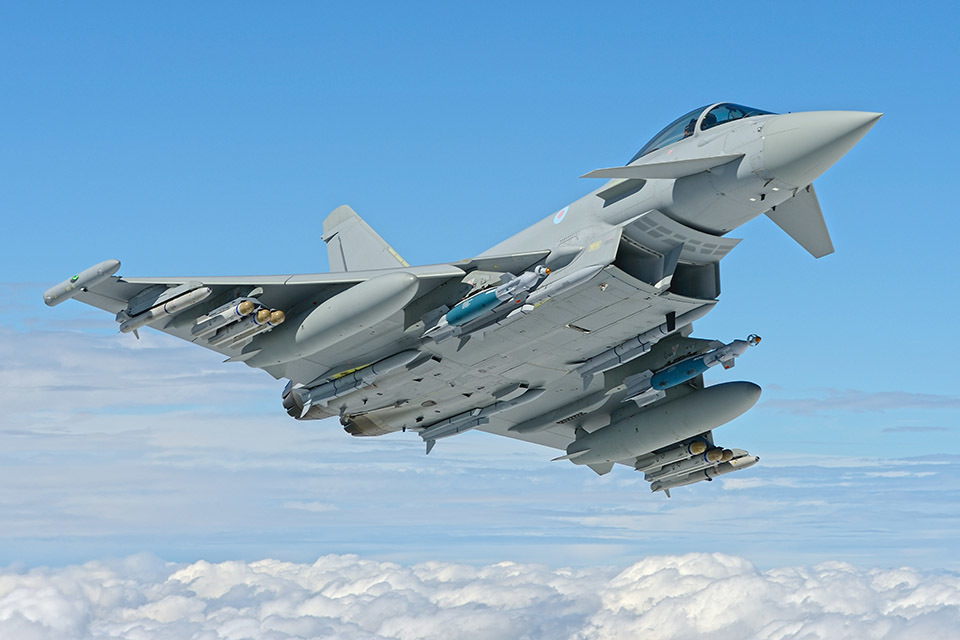
Counter-drone tech and state-of-the-art radar for the raf
- Select a language for the TTS:
- UK English Female
- UK English Male
- US English Female
- US English Male
- Australian Female
- Australian Male
- Language selected: (auto detect) - EN
Play all audios:
News story COUNTER-DRONE TECH AND STATE-OF-THE-ART RADAR FOR THE RAF RAF Typhoons are to be equipped with next generation radar thanks to a £317-million investment, Defence Minister Jeremy
Quin today announced. This was published under the 2019 to 2022 Johnson Conservative government The new contract will secure over 600 jobs and make sure the UK remains at the forefront of
radar technology development. The RAF is also one step closer in bringing its ORCUS technology into force, which can jam radio signals from drones and has already been successfully deployed
during drone sightings at airports. CONFIRMING THE NEWS AT THE DEFENCE PROCUREMENT, RESEARCH, TECHNOLOGY & EXPORTABILITY (DPRTE) 2020 EVENT, THE MINISTER, SAID: > It is vital that our
Armed Forces are equipped with the latest > technology to counter emerging threats from our adversaries. > > Today we announce the investment in the latest in radar technology
> for our fighter jets and pioneering new defence systems to counter > threats from drones. This demonstrates our commitment to maintaining > security in the air whilst supporting
highly-skilled jobs across the > UK. TYPHOON RADAR Typhoon aircraft will be equipped with next-generation radar thanks to £317-million investment that will allow it to locate, identify
and suppress enemy air defences using high-powered jamming. The integration of the new European Common Radar System (ECRS) Mk2, which is based on Active Electronically Scanned Array (AESA)
technology, will provide a capability edge in the increasingly contested battlespace. Currently fitted with mechanically-scanning radar, the Typhoon is designed to be continuously upgraded
to meet operational demand no matter the challenge or threat. The ECRS Mk2 will allow the aircraft to simultaneously detect, identify and track multiple targets in the air and on the ground
in the most challenging environments. Planned to be in service by the mid-2020s, the radar development programme will sustain hundreds of highly skilled jobs, including more than 300 at
Leonardo’s Edinburgh site and 100 at their Luton site; 120 at BAE Systems’ site in Lancashire and 100 at their site in Dunfermline, Fife; and 50 at sub-contractor Meggitt in Stevenage.
COUNTER-DRONE TECHNOLOGY The Royal Air Force’s SYNERGIA counter-drone research and development programme has reached a significant milestone with the ORCUS counter-drone capability achieving
initial operating capability (IOC). IOC was achieved after ORCUS completed successful testing of a full range of integrated detect, track, ID, and defeat technologies. Vital to protecting
UK air bases from hostile drone activity, ORCUS will enable the RAF to evaluate a range of capabilities including advanced radar, electro-optic and radio frequency sensors, plus an
electronic attack countermeasure. The device looks similar to a camera module placed on top of a tripod, allowing for unparalleled versatility in operations. The technology is part of the
RAF’s Counter-Unmanned Aerial System (C-UAS) research and development programme with Leonardo to establish the most effective way to detect, track, identify and defeat hostile drones.
Elements of Leonardo’s C-UAS equipment played a supporting role in RAF Force Protection in 2018 and 2019, following drone sightings at Gatwick and Heathrow airports, allowing airport
operations to resume. The current phase of the programme, which started in 2019, supports more than 50 highly skilled jobs with over 20 at Leonardo, with the primary integration work
undertaken at its Basildon and Southampton sites and real-time testing taking place at several MOD locations within the UK. SHARE THIS PAGE The following links open in a new tab * Share on
Facebook (opens in new tab) * Share on Twitter (opens in new tab) UPDATES TO THIS PAGE Published 3 September 2020